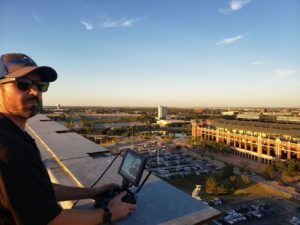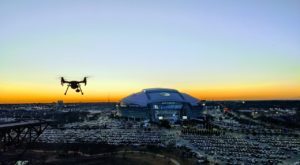 Hidden Level teams with local police to guard Texas stadiums from illegal drones at sporting events
Hidden Level teams with local police to guard Texas stadiums from illegal drones at sporting events
By Jim Magill
Sensor system provider Hidden Level has teamed up with the Unmanned Aerial Systems unit of the Arlington, Texas Police department to protect the city’s sports and entertainment district from illegal drone incursions.
The company’s Airspace Monitoring Service has proven effective at helping law enforcement personnel detect an average of two unauthorized drones per game during the Dallas Cowboys’ regular season at AT&T Stadium. Using one of its own drones, hovering in a fixed position near the stadium, the Arlington PD is often able to spot and deal with the pilot of the unauthorized drone.
The most recent drone-related security incident in the area occurred on January 16, less than 30 minutes before the kickoff in the playoff game between the Cowboys and the San Francisco 49ers. The FAA has a standing temporary flight restriction (TFR) against flying within three nautical miles of a stadium, hosting a game involving the National Football League (NFL), Major League Baseball (MLB) or National Collegiate Athletic Association Division A, beginning an hour before the start of the game.
“A lot of folks don’t even know how many times a TFR is violated because there’s no way to monitor that and to assess how much of a safety risk there is,” said James Licata, Hidden Level’s vice president of strategy and partnerships.
The company, which began sharing information from its sensor network with the Arlington P.D. last September, has recorded an average of more than two incidents of unauthorized drone use per NFL game at the AT&T stadium, one of three major sports venues in the entertainment district.

“We had 22 different infractions during the nine NFL games that were in Arlington, Texas. That wasn’t even counting the two NCAA football games that happened during the time we’ve been up, and now we’ll have baseball season,” Licata said.
In addition to AT&T Stadium, the Entertainment District includes Choctaw Stadium, the former home of Texas Rangers, and the recently built Globe Life Park, the new MLB ballpark. The district is also home to several other large public venues including, Six Flags Over Texas amusement park, the National Medal of Honor Museum and the Esports Stadium Arlington & Expo Center.
In the January 16 incident, Hidden Level’s sensors identified an unauthorized drone flying in the vicinity of a Wal-Mart within the area covered by the stadium TFR and alerted Arlington P.D., said Lt. Neal Landfield, who oversees the department’s UAS unit. The department has FAA authorization to maintain a drone hovering at a fixed altitude near the stadium. The UAS uses a zoom camera to keep an eye on areas that could serve as possible drone take-off sites.
“My drone pilot zoomed in on the Wal-Mart parking lot, trying to find the person looking at the sky with a controller in their hand,” Landfield said. The police drone pilot spotted just such a person and forwarded the location to Arlington P.D. bicycle patrol officers, who were then able to make contact with the suspect.
Although the officers did not make an arrest or issue a citation, they forwarded the drone pilot’s name to Kenny Maldanado, FAA’s regional Law Enforcement Assistant Program agent, for potential further discipline.
Three directional sensors deployed to detect illegal drones at sporting events
The Hidden Level system employs three sensors to monitor the airspace in and around the entertainment district: one is on a municipal office tower; another is on top of the CenterPoint Building – the home of the North Central Texas Council of Governments — and the third sits atop the Texas Health Resources Building. The directional sensors point towards each other and have overlapping fields of coverage, encompassing the entire stadium complex area, Landfield said.

The system employs passive-detection technology, which examines the radio frequencies (RF) emitted by drones to determine the aircraft’s location. Unlike some other drone-detection systems, Hidden Level is not intercepting packets of data or interfering with communication between the drone and its pilot.
“We do this in a unique way. There are ways of doing this where folks don’t violate the different regulations and rules concerning intercepting communications,” Licata said.
Unauthorized drone flights near sporting venues are becoming a growing problem across the country.
On the same day as the incident at AT&T Stadium, a more intrusive incursion occurred at Paul Brown Stadium in Cincinnati during a playoff game between the Bengals and the Las Vegas Raiders. An unidentified drone reportedly flew over the crowded stadium and footage of the illegal flight was posted to YouTube.
Irresponsible drone pilots are likely to blame for the vast majority of authorized drone incursions around stadiums, Licata said. “90-plus percent of the time that you’re going to run into these things, it’s because of folks who don’t know the rules and are ignorant, or it’s folks that think there aren’t any consequences for violating the rules.”
While no injuries occurred as a result of the drone incursion at either the Cowboys or Bengals playoff games, Licata said the potential safety and security threats from such incidents are real and very serious. “I think the reality of security threats is something that is continuously considered and monitored, especially for larger-scale events,” he said.
Read more about Hidden Level: Airspace Monitoring During Monday Night Football: Hidden Level Launches ASM in Arlington, TX
Read more in-depth articles by Jim Magill:
- American Robotics CEO Reflects One Year After Receiving First FAA Approval for Autonomous Flight
- Drones for Animal Rescue: Doug Thron Flies Around the World, Saving Pets and Wildlife After Natural Disasters
- Drone Taxis are Big Business: The New Ride Share
- Preventing a Drone Attack on the Pope: D-Fend Solutions Deployed During Open Air Mass
 Jim Magill is a Houston-based writer with almost a quarter-century of experience covering technical and economic developments in the oil and gas industry. After retiring in December 2019 as a senior editor with S&P Global Platts, Jim began writing about emerging technologies, such as artificial intelligence, robots and drones, and the ways in which they’re contributing to our society. In addition to DroneLife, Jim is a contributor to Forbes.com and his work has appeared in the Houston Chronicle, U.S. News & World Report, and Unmanned Systems, a publication of the Association for Unmanned Vehicle Systems International.
Jim Magill is a Houston-based writer with almost a quarter-century of experience covering technical and economic developments in the oil and gas industry. After retiring in December 2019 as a senior editor with S&P Global Platts, Jim began writing about emerging technologies, such as artificial intelligence, robots and drones, and the ways in which they’re contributing to our society. In addition to DroneLife, Jim is a contributor to Forbes.com and his work has appeared in the Houston Chronicle, U.S. News & World Report, and Unmanned Systems, a publication of the Association for Unmanned Vehicle Systems International.

 Hidden Level teams with local police to guard Texas stadiums from illegal drones at sporting events
Hidden Level teams with local police to guard Texas stadiums from illegal drones at sporting events





[…] More… […]